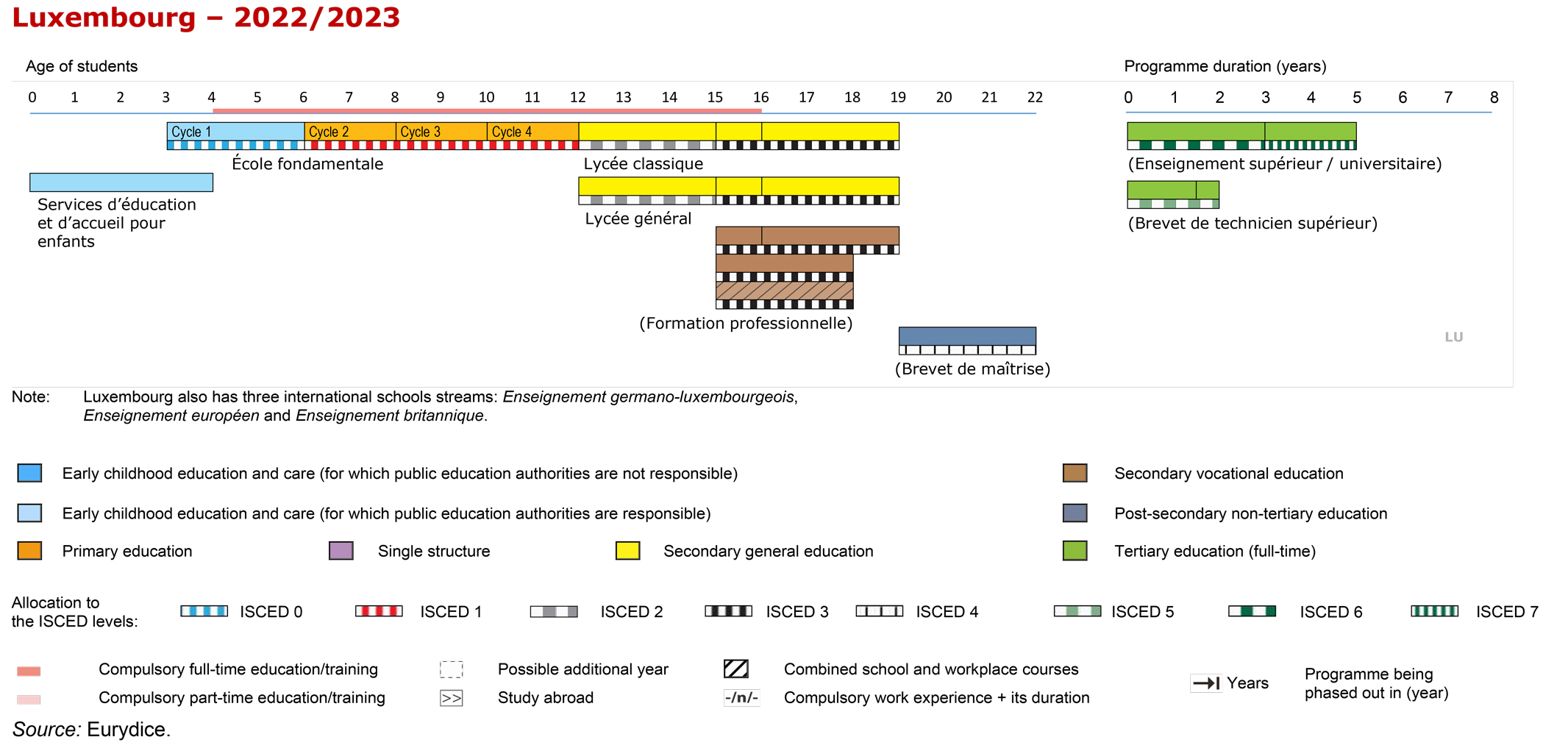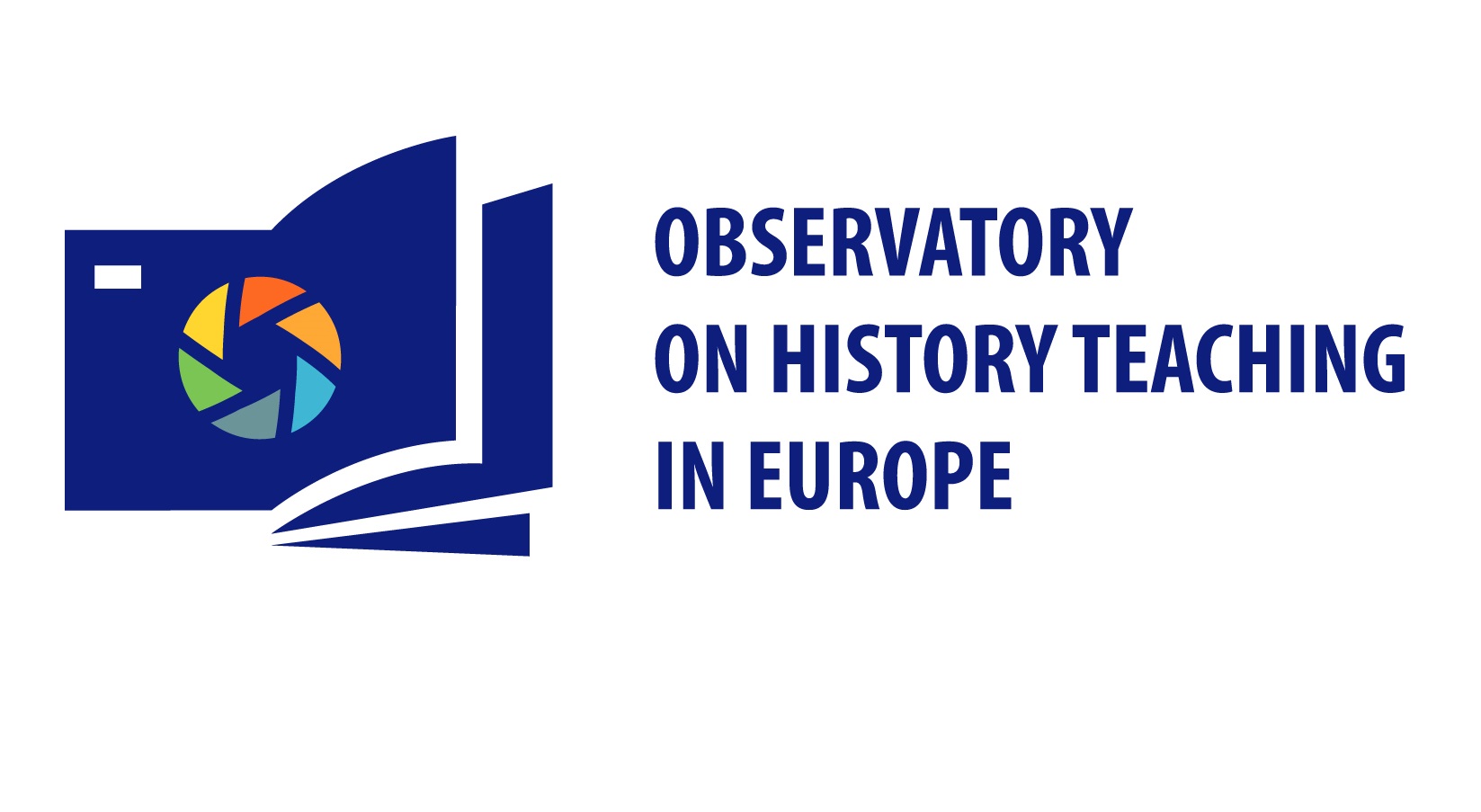Luxembourg
STRUCTURE OF THE NATIONAL EDUCATION SYSTEM
 Source: Eurydice 2022/23
Source: Eurydice 2022/23
The National Ministry of Education, Childhood and Youth controls the curricula of state schools in Luxembourg.
It is a trilingual country with Luxembourgish, French and German as the principal languages, and all three are taught in state schools. Primary education is divided into 15 education directorates that manage, co-ordinate and supervise teaching in the schools. The curriculum has developed over time, resulting in a diversified curriculum designed to meet the needs and wishes of families of different backgrounds, particularly expatriates. In addition to the regular Luxembourgish school system, the international public and private schools allow access to a recognised diploma.
Private elementary schools provide the same curriculum as state schools, although nine private elementary schools (e.g. Montessori schools) are guided by a different curriculum while being subsidised by the state. Five international state primary schools operate according to the curricula, promotion criteria and schedules of the European school system. They are free and open to all pupils. They offer five years of European primary education in one of French-, English- or German-speaking sections. Students can then pursue secondary education leading to the European Baccalaureate. There is a syllabus commission for each subject area. Their role is to propose curricula as well as textbooks, which are then submitted to the ministry for approval (Eurydice 2010).
Secondary education is provided by state schools, private schools teaching the official curriculum of the ministry, private schools teaching a different curriculum, and European schools (www.men.lu).
State high schools start at the age of 12, and attendance is mandatory until the age of 16. A full high school cycle (up to the age of 18) lasts seven years. State-run education is subdivided into:
- classic secondary education (ESC)
- general secondary education (ESG)
- European education (leading to the European Baccalaureate)
- international education
- British education
- German-Luxembourgish education.
The classic route (ESC) is, in principle, reserved for pupils with a very good level of mathematics, French and German. The general route (ESG) is typically more vocational. The learning is organised in two main stages: lower classes (years 7, 6 and 5: ages 12-14) and higher classes (years 4, 3, 2 and 1: ages 15-18). Years are counted downwards.*
For more information on the national education system in Luxembourg, please visit:
Ministry of Education, Children and Youth
*OHTE Thematic report on "Pandemics and natural disasters as reflected in history teaching"
HISTORY IN SCHOOL
Data are currently being collected for the OHTE general report.
This section will host information on the space and time provided to ‘History’ as a subject matter within the three main levels of education (primary, lower secondary and upper secondary). It will also provide insights on the relationship between history and other school subjects.
HISTORY CURRICULUM
Data are currently being collected for the OHTE general report.
The national history committees define the main lines of the curriculum. While the history curriculum broadly outlines what is to be taught, it allows for a flexible approach to teaching. Primary education is based on core
competences and skills rather than subjects. Cycle 1 (ages 3-5) has a very broadly defined curriculum: “Discovering the world using all the senses” is the closest it comes to history. In cycles 2-4 (ages 6-11) there is again no history, although development and learning fields include “Discovering sciences as well as human and natural sciences”.
Specific curricular content is sometimes generated by a school, or consortium of schools, and then validated by the national, regional or other competent authorities. Teachers have the freedom to choose areas of the broad curriculum to emphasise aspects they consider appropriate.
In secondary schools, history forms part of humanities and social sciences in the ESC and ESG routes. In the case of the ESC route, history as a subject is taught from ages 12-18 for two hours per week, with an hour of civic
education per week in the second last year known as 2ème (ages 16-17). The ESG route offers social sciences, comprising history, geography and economics, which in orientation education are taught for three hours per
week. In international programmes, if history is an International Baccalaureate choice, it is accorded three hours per week in 2ème and five hours per week in 1ère.*
Curricula workstation by GEI (History curricula search by country)
*OHTE Thematic report on "Pandemics and natural disasters as reflected in history teaching"
LEARNING OUTCOMES AND ASSESSMENT
Data are currently being collected for the OHTE general report.
This section will contain information on the learning outcomes set for history lessons within the different levels of education and on the methods of testing and assessment used in history examinations.
EDUCATIONAL RESOURCES AND PEDAGOGY USED IN THE HISTORY CLASSROOM
Data are currently being collected for the OHTE general report.
This section will host data on the study material and teaching practices used for history teaching within the different levels of education.
International TextbookCat (GEI collection of Textbooks and Educational Media)
HISTORY TEACHERS
Data are currently being collected for the OHTE general report.
This section will provide an overview of the number of history teachers within the different levels of education, as well as relevant information on teachers’ initial training and in-service training available to them.
Luxembourg Association of Teachers of History (presentation by EuroClio)
THEMATIC DATA
The Observatory on History Teaching in Europe also provides thematic studies on given topics.
2022: Pandemics and natural disasters as reflected in history teaching



